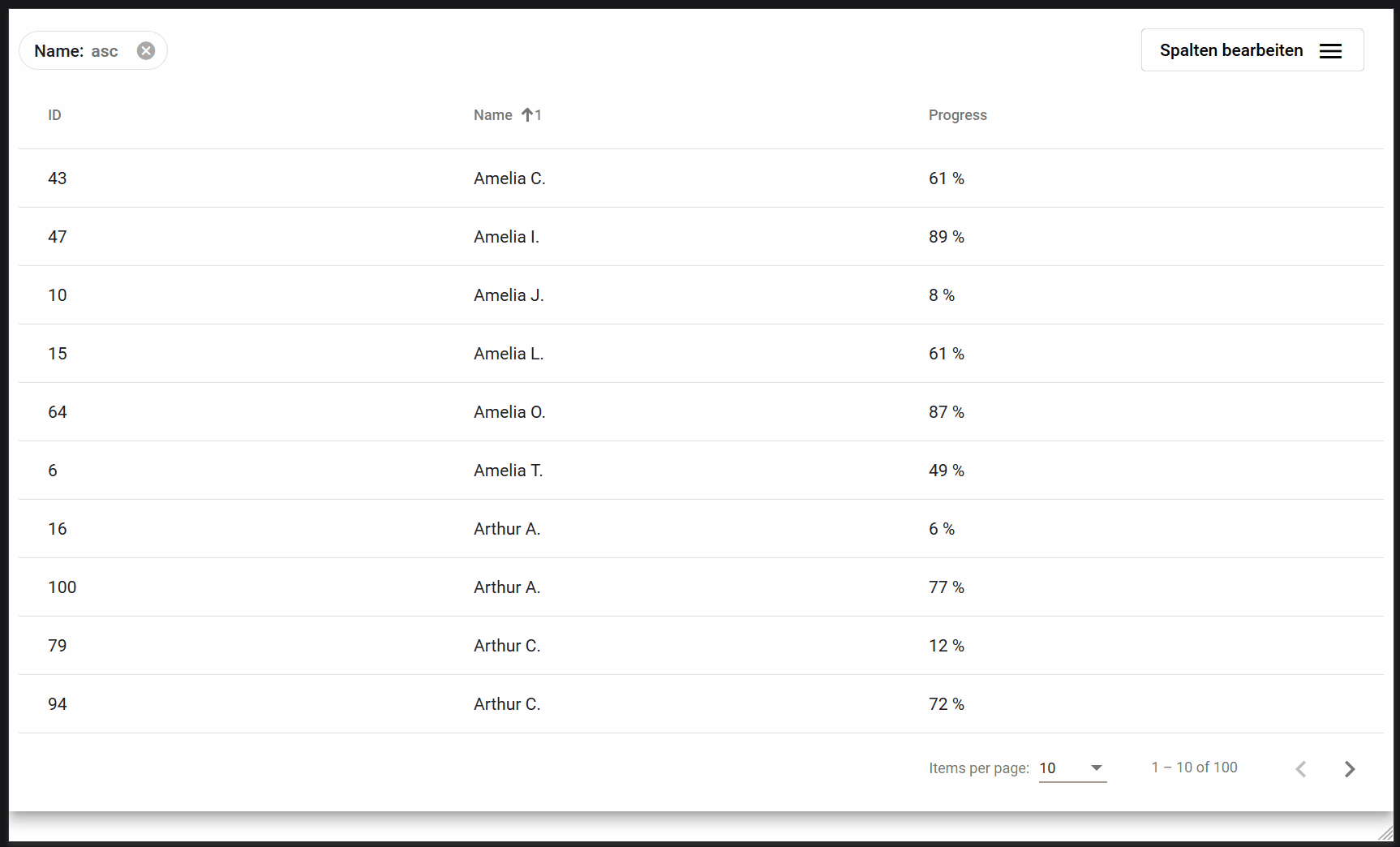mat-multi-sort v0.0.2
NgxMultiSortTable
This is the implementation for a multiple sortable table based on the Angluar Material Design. The focus is on server-side loaded and sorted data. Next to that the libarry provides some unsefull classes to reduce the duplicated code when useing the material paginator.
The code is based on Francisco Arantes Rodrigues repository repo, so thanks for your great work.
The provied example is based on Angular 8 and Angular Material 8, I have not tested previous versions.
Client side multi sorting is not implementes yet, it might follow in the future or feel free to make a pull request.
Demo
To run the demo:
1. clone the repository
2. cd ngx-multi-sort-table
3. npm install
4. ng build multi-sort-table
5. ng serve
Screenvideo

Documentation
TableData
The TabelData an an usefull class, which handels a lot of work for your app, such as page events (next, previous, sizeChange) and sorting event. Next to that it keeps the current state of the table, again sorting and pagnation.
Properties
| Name | Description | default | Exampe |
|---|---|---|---|
| columns | An array of the displayed columns of the table with id: name of the attribute and name: Name to display in the header | none | [{ id: 'first_name', name: 'First Name' }] |
| displayedColumns | An array of the currently displayed columns (id) and their order | all columns | |
| dataSource | A MatMultiSortTableDataSource, which is special DataSource for sorting | none | |
| pageSize | The current selected pageSize | first entry of pageSizeOptions | |
| pageSizeOptions | The options for the pageSize, which the user can see in the menu | [10, 20, 50, 100] | |
| pageIndex | The index of the page | 0 | |
| totalElements | The total number of elemnts of the table, must be set from your component | none | |
| sortParams | An Array of the columns (id), which the user had chosen to sort. The order of the sorting is represented by the order of the ids in the parameter | [] | ['first_name', 'last_name'] |
| sortDirs | An Array of the column's sortdirections, which the user had chosen to sort. The order is the same like sortParams | [] | ['asc', 'desc'] |
| nextObservable | An Observable that fires, when the user clicks the next button | ||
| previousObservable | An Observable that fires, when the user clicks the previous button | ||
| sizeObservable | An Observable that fires, when the user changes the pageSize | ||
| sortObservable | An Observable that fires, when the user changes the sorted columns or direction |
Methods
| Name | Description | Parameter |
|---|---|---|
| constructor | The constructor for the for the class, where you initalize your columns. Optionally, you can add the default ids of the default sort colum and direction. | columns: string[], totalElements: number, options: { defaultSortParams?: string[], defaultSortDirs?: string[], pageSizeOptions?: number[], totalElements?: number } |
| onSortEvent | The method to bind to the matSortChange output of the table | none |
| onPagnationEvent | The method to bin to the page output of the mat-paginator | $event: PageEvent |
| setDisplayedColumns | A method to set the columns of the table. It should get bind to the activeColumnsChange output of mat-multi-sort-table-settings, in order to enable / disable and reorder the columns | columns: string[] |
MatMultiSortHeaderComponent
This component manages the sorting of the table. To use the multisort add matMultiSort to your table and pass the mat-multi-sort-header="<your-column-id>" to the <th mat-header-cell>.
MatMultiSortTableSettingsComponent
This component display some settings for your table. The user can select the columns he wants to see in his table, next to that he can change the order of the columns.
| Name | Description | Parameter |
|---|---|---|
| columns | An input to definde the columns to display in the menu. The id is the column id and name the name to display in the menu | @Input: { id: string, name: string }[] |
| activeColumnsChange | The ouput gives the order of th currently display columns id and their order | @Output: string[] |
Example code for the template
<div class="mat-elevation-z8">
<mat-multi-sort-table-settings [columns]="table.columns" (activeColumnsChange)="table.setDisplayedColumns($event)"></mat-multi-sort-table-settings>
<table mat-table [dataSource]="table.dataSource" matMultiSort (matSortChange)="table.onSortEvent()">
<ng-container matColumnDef="id">
<th mat-header-cell *matHeaderCellDef mat-multi-sort-header="id"> ID </th>
<td mat-cell *matCellDef="let row"> {{row.id}} </td>
</ng-container>
<ng-container matColumnDef="progress">
<th mat-header-cell *matHeaderCellDef mat-multi-sort-header="progress"> Progress </th>
<td mat-cell *matCellDef="let row"> {{row.progress}} % </td>
</ng-container>
<ng-container matColumnDef="name">
<th mat-header-cell *matHeaderCellDef mat-multi-sort-header="name"> Name </th>
<td mat-cell *matCellDef="let row"> {{row.name}} </td>
</ng-container>
<tr mat-header-row *matHeaderRowDef="table.displayedColumns"></tr>
<tr mat-row *matRowDef="let row; columns: table.displayedColumns;"></tr>
</table>
<mat-paginator [pageSize]="table.pageSize" [pageIndex]="table.pageIndex" [pageSizeOptions]="table.pageSizeOptions"
[length]="table.totalElements ? table.totalElements : 0" (page)="table.onPagnationEvent($event)">
</mat-paginator>
</div>Example code for the component.ts
displayedColumns = ['id', 'name', 'progress'];
table: TableData<UserData>;
@ViewChild(MatMultiSort, { static: false }) sort: MatMultiSort;
constructor(
private dummyService: DummyService
) {
this.table = new TableData<UserData>(
[
{ id: 'id', name: 'ID' },
{ id: 'name', name: 'Name' },
{ id: 'progress', name: 'Progess' }
], 100
);
}
ngOnInit() {
this.table.sortObservable.subscribe(() => { this.getData(); });
this.table.nextObservable.subscribe(() => { this.getData(); });
this.table.previousObservable.subscribe(() => { this.getData(); });
this.table.sizeObservable.subscribe(() => { this.getData(); });
setTimeout(() => {
this.table.dataSource = new MatMultiSortTableDataSource(this.sort);
this.getData();
}, 0);
}
getData() {
const res = this.dummyService.list(this.table.sortParams, this.table.sortDirs, this.table.pageIndex, this.table.pageSize);
this.table.totalElements = res.totalElements;
this.table.pageIndex = res.page;
this.table.pageSize = res.pagesize;
this.table.dataSource.setTableData(res.users);
}